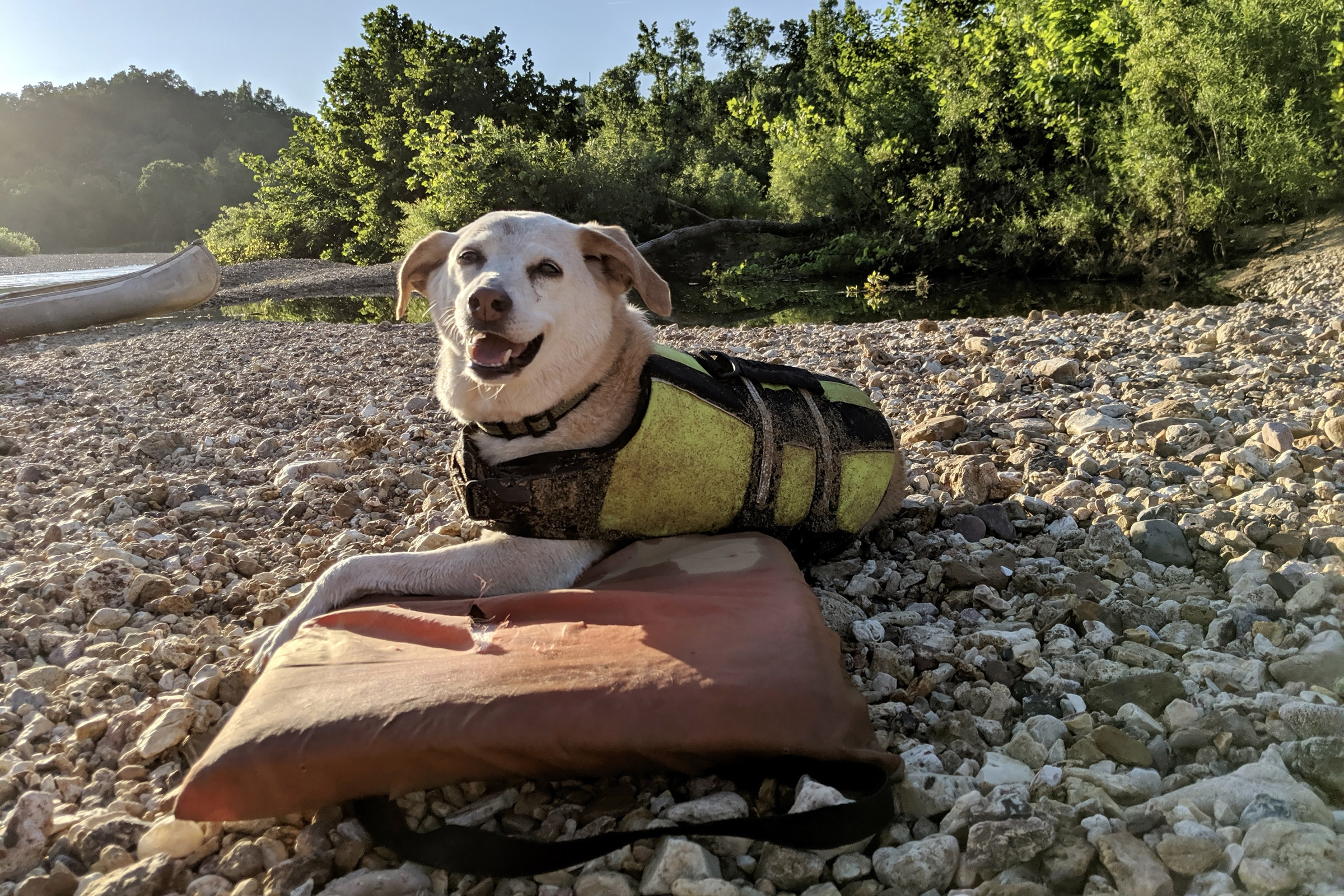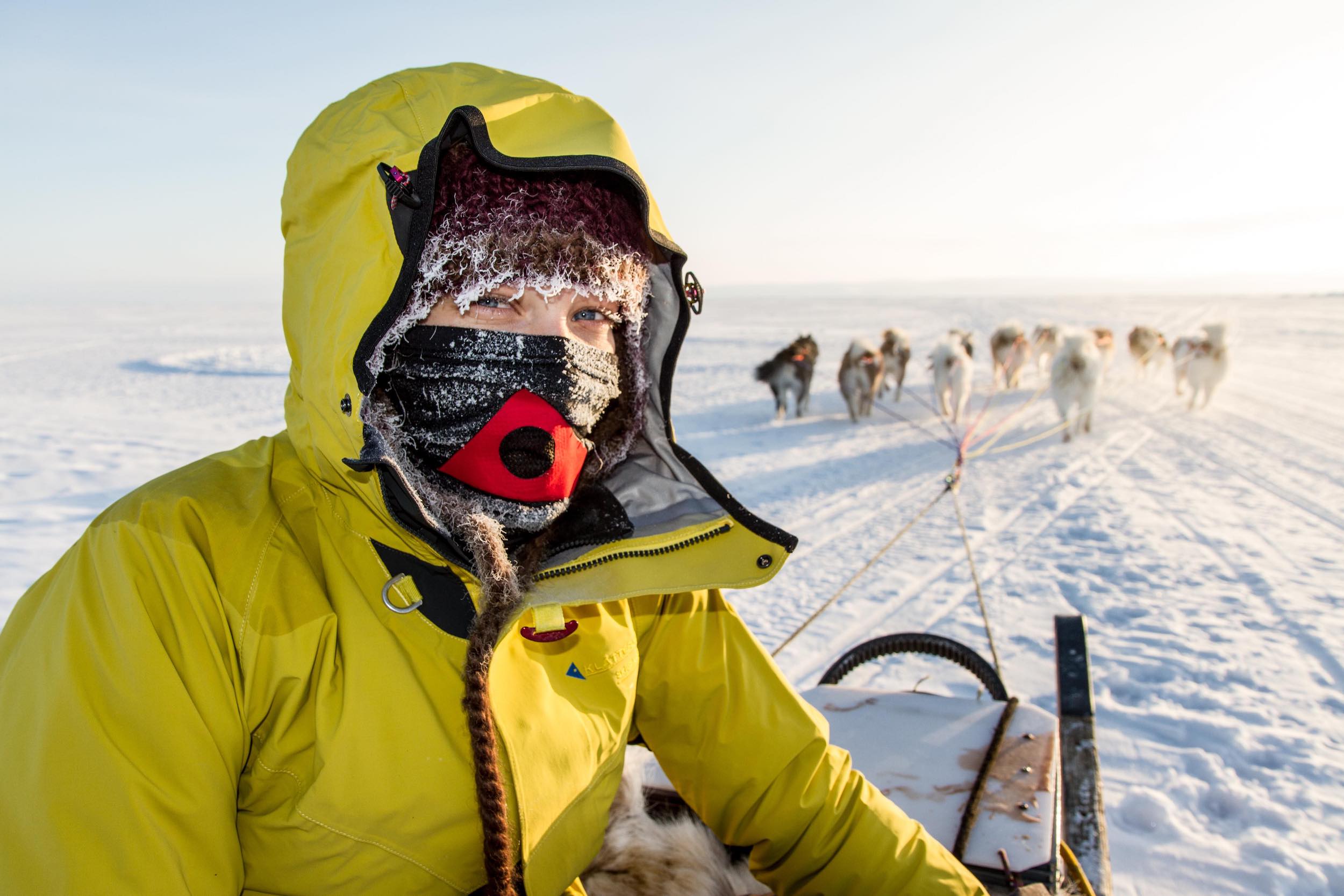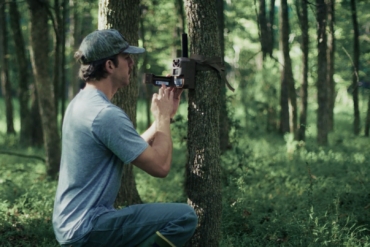My beloved adventure dog, Darwin, is now 13 years old. He has been backpacking, kayaking, joining us on climbing trips, and running beside a bicycle since he was a pup. He’s escorted hikers up and down countless trails, and he’s kept great and respectful company for anyone who leaves the campfire to find somewhere to pee.
But as our pace of adventure has remained the same, his has slowed down. Running behind mountain bikes turned into long hikes with his humans, backpacking trips became car camping excursions, and multiday canoe trips were replaced with shorter day floats.
As Darwin has aged, we’ve made adjustments so he can still enjoy the things he loves to do with us, even as his whiskers gray.

There’s no magic bullet for knowing how to meet your dog’s needs as they age. Every dog, like every person, is different. Breed, temperament, and fitness level are just some of the factors that affect when an activity might catch up to a dog or at what age — to say nothing of conditions and diseases that aging dogs are commonly diagnosed with.
Here are some of the things we’ve learned with Darwin, as well as some advice from Dr. Margaret Gruen, a professor of behavioral medicine at North Carolina State University’s College of Veterinary Medicine, on how to adjust active routines for aging dogs.
Because old dogs still love to adventure, even if they’re a little slower than they used to be.
Tips for Adjusting Active Routines for the Aging Adventure Dog
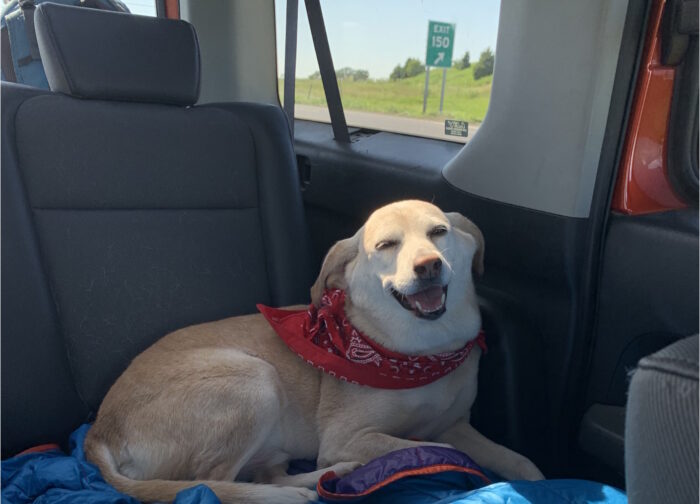
Look for Signs of Aging
Knowing what to look for is imperative to recognizing that your dog’s age might be affecting them, explained Gruen, so watch for early signs.
“The first signs [of aging] are hesitating to do behaviors that they normally do automatically or smoothly,” she said. That could mean pausing before going up or down the stairs, moving across hardwood floors, or jumping into the car. Gruen said noticing these behaviors as they start to happen is key to being able to intervene.
If you notice your dog slowing down on longer hikes or bike rides, it might be time to start to shorten the ones you take them on. If you notice them hesitating or struggling to jump in the car, perhaps reconsider those shaley, above-treeline 14er ascents. And if your pup can’t swim for as long they used to, maybe they forego big river trips.
It’s hard to say what aging will look like for your dog, according to Gruen. There are a lot of variables that factor into physicality and life expectancy — breed being one of the most important.
“You can’t make a blanket statement about 14-year-old dogs, because 14 is quite old for some breeds and middle age for others,” Gruen said.
Larger dogs can be more prone to arthritic disease. Glucosamine supplements have helped stave off joint issues for Darwin. CBD has also become a popular supplement for aging dogs, helping to reduce inflammation and joint pain. And Gruen adds that it’s important to keep your dogs moving and active.
“Just like people, exercise remains really important for joint mobility and overall health,” said Gruen. “Making small changes where we can so we can preserve that activity as long as possible is really helpful.”
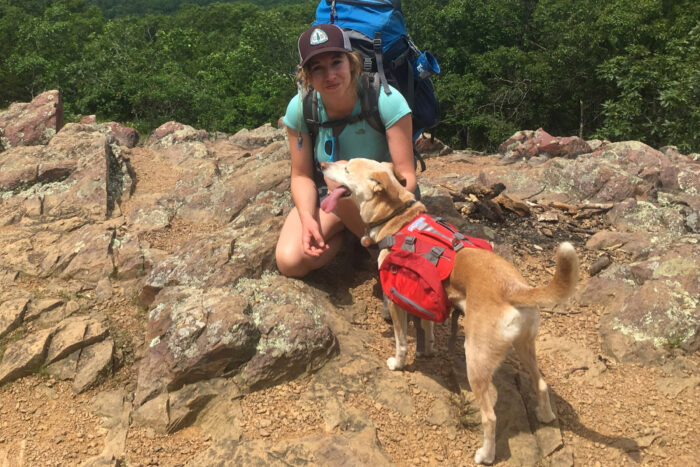
Understand a Dog’s (Changing) Limits
One of the most admirable qualities of canine companions is that they are faithful to a fault. Darwin will gladly overexert himself if it means getting to be by my side. This kind of loyalty comes with grave responsibility on our part as humans. I need to be able to predict how much he can actually handle and turn back before risking his health, even as he tries to sail past his limits.
According to Gruen, Darwin isn’t alone in not understanding his own limitations, and pushing past them — especially among dogs whose limits are changing. That’s why owners should not only keep an eye on their aging dog during exercise, but after it as well.
“They’re excited to be out; there’s lots of stimulation; there’s the social bond with their person. They may not recognize that they should slow down,” Gruen said. “[It’s about] watching not only how they do during the activity but also afterwards — do they take more time to recover? Are they slower standing up? Do they seem stiff?”
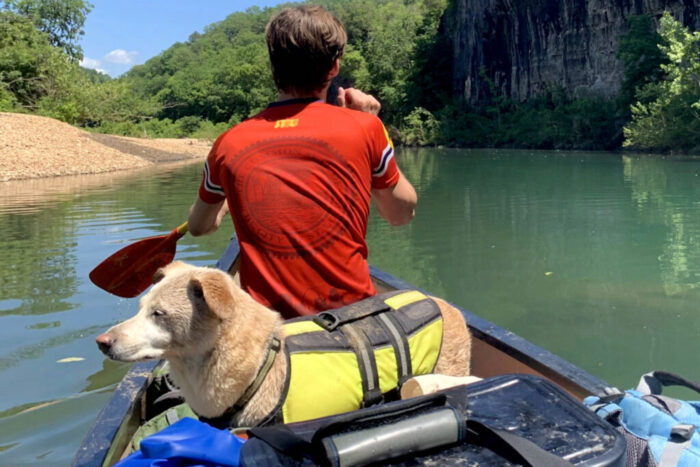
Help Your Dog Recover
Whether your dog is older or younger, you can help facilitate their recovery after exercise. CBD is used by a lot of athletes for physical recovery, and many companies make CBD dog treats that can help canines do the same. Dogs also need a lot of rest between exercise intervals, but also just in general. On average, dogs need 12-14 hours of sleep a day, according to Pet.MD — and that only gets more important with age.
Gruen also suggests doggie massages help sore muscles recover better (but also just because they feel great). And having a comfortable, supportive dog bed makes a big difference too, Gruen added. Taking small steps like these as your dog gets older will help them recover faster and keep them on the trail longer.
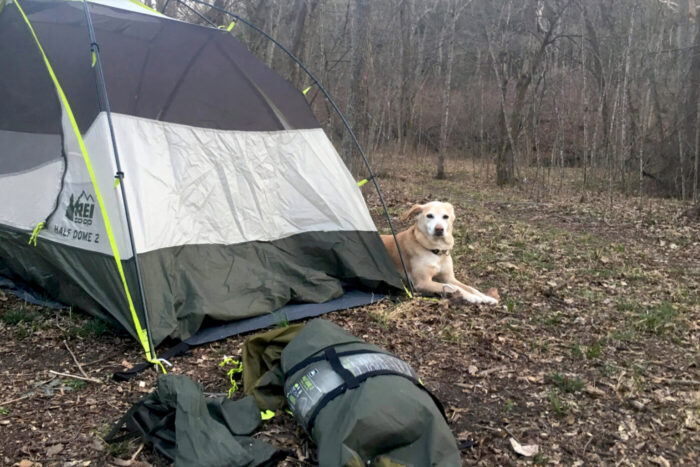
Set Realistic Trip Goals
One of the worst parts of watching your best friend age is knowing you can’t take them on some of the trips you enjoyed before. I know this feeling well — the pang of guilt that I’m going to go enjoy a day outdoors that Darwin isn’t fit for anymore hurts. But alleviating my own guilt isn’t worth hurting my dog. So, these days, for every long hike or trip that I do on my own, I try to plan a subsequent trip around Darwin’s abilities.
Dr. Gruen says this feeling is common. “The shift that starts to happen is, ‘Are we doing this as something we’re doing together, that we both enjoy?’ or, ‘Is this something that’s for me, and I need to take my dog on a separate walk that’s for them?’”
She stresses there are so many ways to enjoy the outdoors with your aging companion. There are low-impact activities like walks and hikes. Swimming can also be great for aging dogs who like the water. And, eventually, you might start to introduce some other gear to make sure your dog is still included in your adventures.
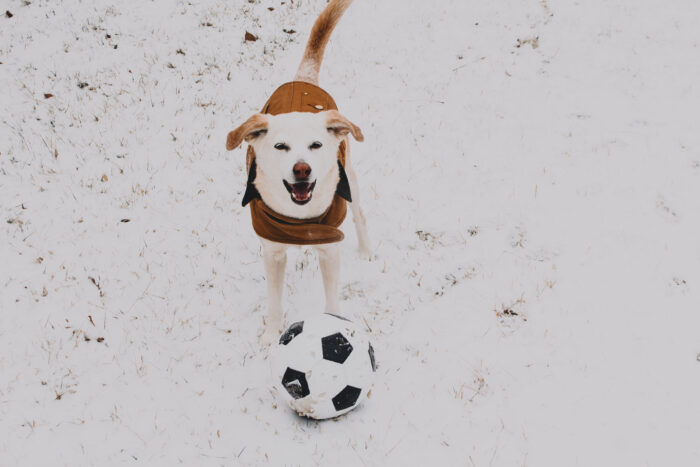
Consider Climate, Weather, and Accessories
Weather patterns and climate will also affect when and what activities are appropriate for your dog. Because they lack sweat glands and rely on panting to cool themselves down, canines struggle to dissipate heat well.
That means hot, dry days can be really hard on aging dogs, Gruen explained. Dehydration is one risk. But heat stroke and heat exhaustion also present serious threats to dogs both young and old.
Companies like Ruffwear make cooling vests that can help canines better regulate their body heat. Booties can also help protect paws from sharp rocks, cactuses, and ice — although they take some getting used to.
With Darwin, I use Musher’s Secret paw pad protection wax in the winter time, which helps prevent pad cracks and ice balls from forming in his paws. There are plenty of companies that make insulated dog jackets to keep dogs with thin coats warm in the winter as well.
Just like people, dogs become more sensitive to more extreme temperatures as they age. They may not be able to handle the cold days like they used to, or run in the heat for as long. Adding accessories like the above can help for a while. But eventually there comes a day when you have to leave your dog at home, and you wouldn’t have before.
At which point, you might consider introducing other tools. Almost any activity can be adjusted to in order to keep your canine companion involved.
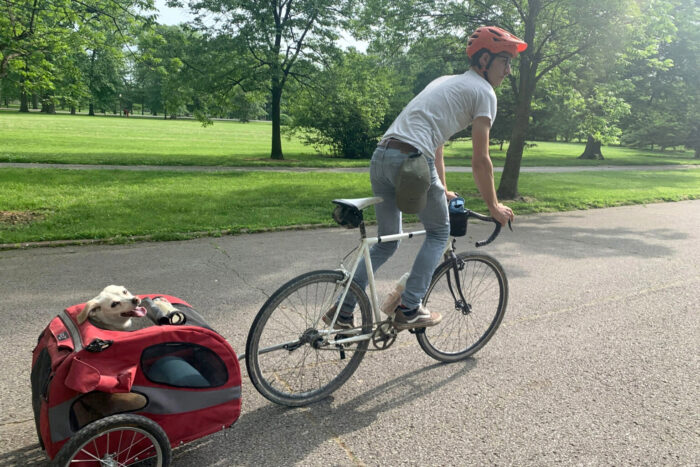
Adjusting to Your Dog’s Pace
As dogs lose mobility, Gruen suggests adapting some adventures with tools like pet strollers and bike trailers. “[Trailers] can be really great for dogs. They still get out. They get the air, they get the enrichment,” Gruen said.
I love using our dog trailer with Darwin. We’ve used it for everything from trips to farmers markets or the park, to longer excursions and bikepacking trips on mellow, protected trails. When he’s feeling up to it, Darwin can still get out and run alongside the bike. And when he’s tired, he rides in the trailer.
Your daily walks and day hikes might start to change eventually, too. Darwin used to have to “heel” during his walks. But in his age, he’s developed diabetic-induced cataracts and has lost much of his vision. It’s clear that these days, he just wants to sniff all he can and enjoy the fresh air with the strongest sense he has left.
Dr. Gruen called this type of exercise a “sniff walk.” “Walking and having the chance to sniff the environment can be extremely enriching for dogs,” she said. Slowing down your hikes and walks isn’t just good for an older dog’s physical endurance and well-being. It’s also good for their spirit too.
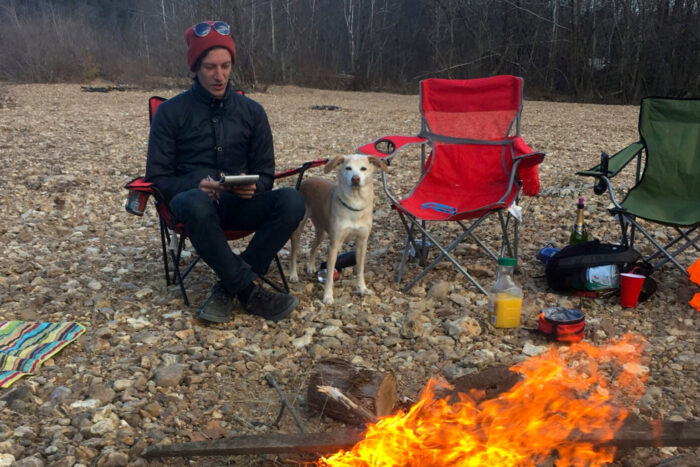
Find Balance in Old Age Outdoors
Good owners all want to protect their aging dogs from getting overstressed or injured. But Gruen pointed out, that it’s just as important not to restrict their activity too much. Exercise is key to a healthy lifestyle and helps extend a dog’s life, just as it does with humans.
“Getting out and moving is good for them,” Gruen said.
Finding ways to make your dog comfortable in the outdoors is also helpful. We pack extra snacks and now take a plush bed on day hikes so Darwin can relax comfortably by the picnic table while we enjoy a beer. (Spoiled, I know.)
For his advancing cataracts, Rex Specs UV goggles have helped mitigate the irritation of bright sunshine so he can still enjoy kayak trips with us. And luckily, travel coolers for insulin have also made it easy to still bring him camping for the weekend.
Even if your dog’s activity has to be restricted, there are still ways for them to get enrichment. Snuffle mats and training can provide important mental stimulation. And for owners, Gruen recommends the book, “No Walks? No Worries!“ by Sian Ryan for dogs who require restricted movement from surgery or other injuries.
The Final Word: Adjusting Active Routines for the Aging Adventure Dog
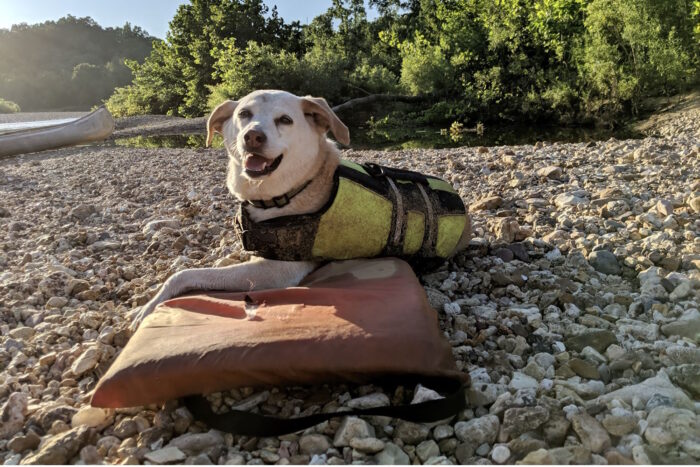
Finding the right activity and pace for an aging dog is about paying attention to their needs and keeping an eye out for the telltale signs of aging along the way. Many of the recommendations in this article aren’t so different from what we would consider for ourselves: Work on recovery after exercise. Use tools and accessories to make your dog more comfortable. Engage in low-impact exercise and pain management to keep your aging dog active for longer.
However, when looking for the right routine, it’s just as important not to overcorrect your furry friend into a sedentary lifestyle. Just like humans, activity helps stave off disease and muscle atrophy. And it isn’t all about the physical side of things, either. Exercise helps with mental and emotional stimulation for dogs as well.
Whether your dog is still going hard, accompanying you on grand adventures, or you are looking for ways to help keep them involved and active, the enrichment of keeping them active key to an aging dog’s happiness — even as they start to slow down at your side.
